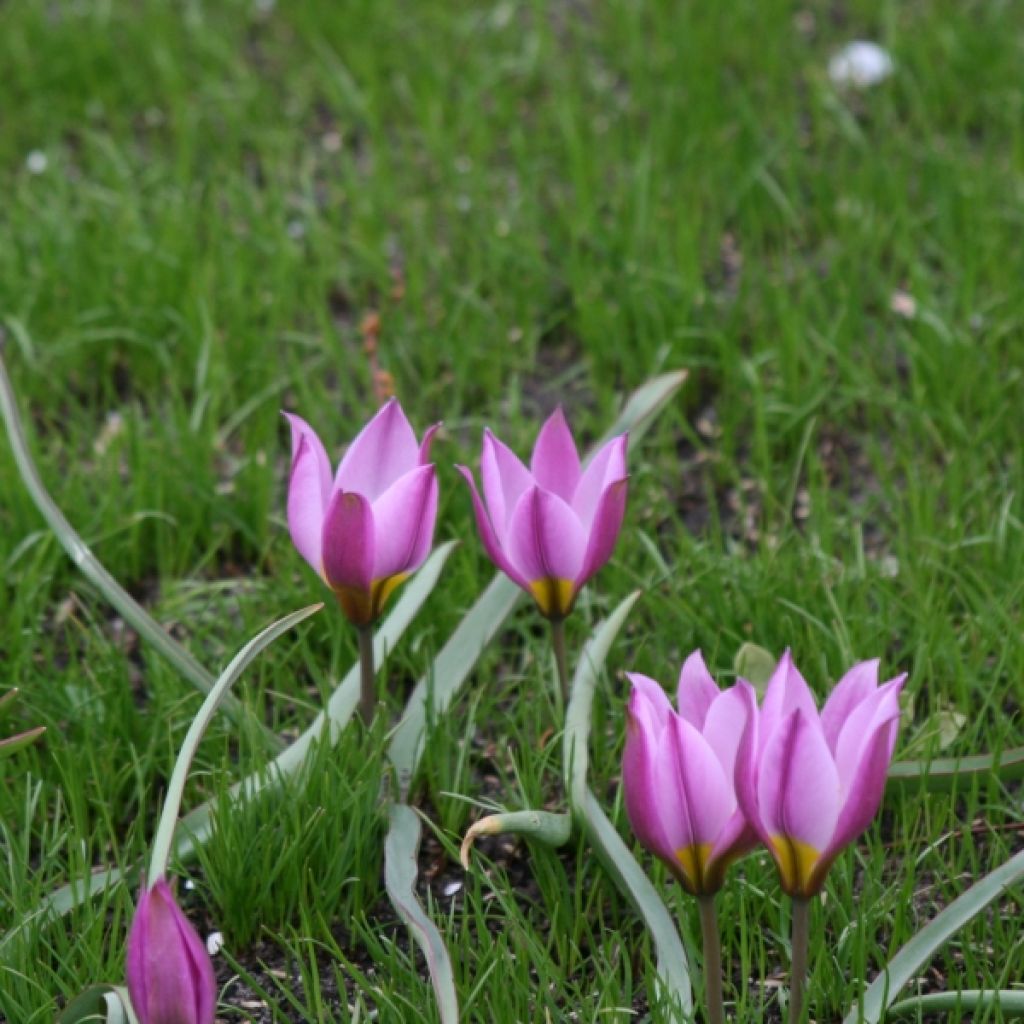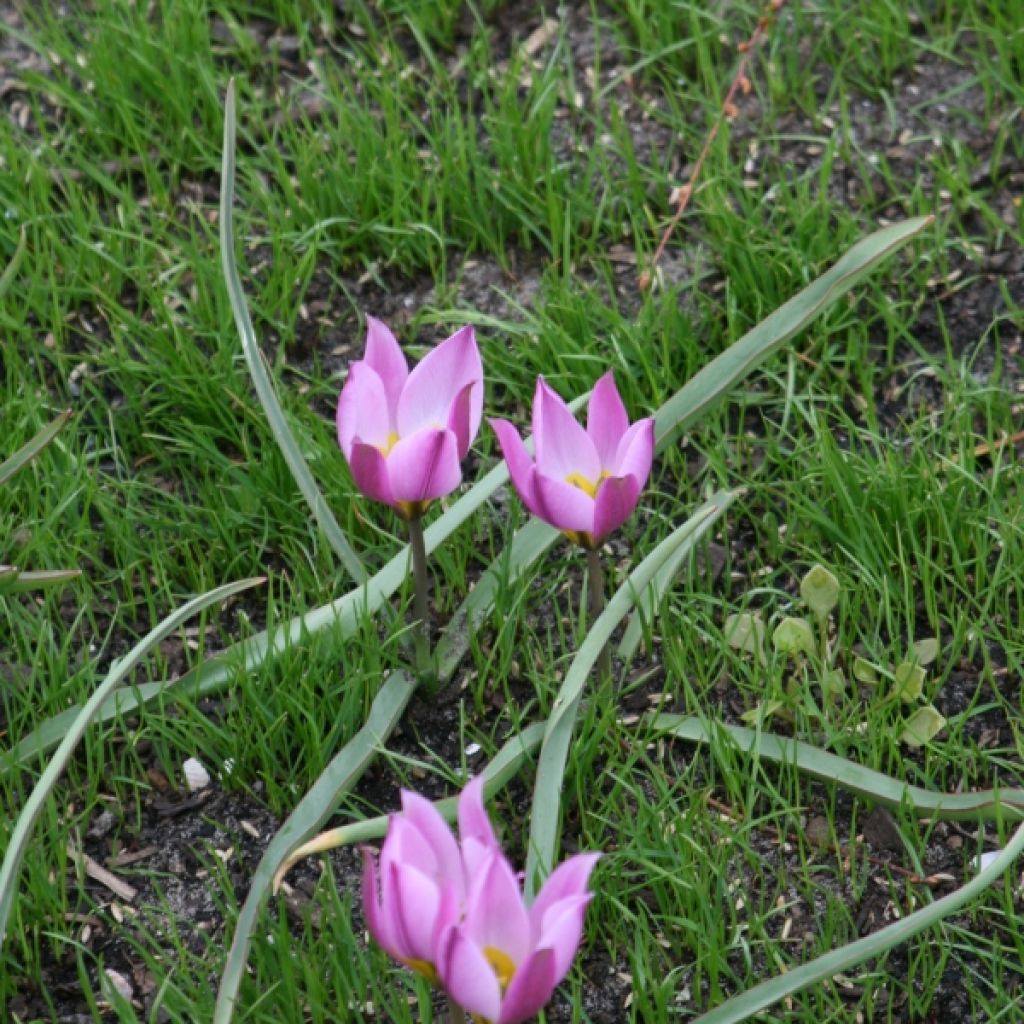

Tulipe Botanique humilis pulchella


Tulipe Botanique humilis pulchella
Tulipa humilis var. pulchella
Tulipa humilis var. pulchella
Very pretty and has a long flowering period - but the colour is much less vibrant and mine don't have the darker side stripes like in the photos here.
Gabriele, 04/03/2024
This plant carries a 6 months recovery warranty
More information
We guarantee the quality of our plants for a full growing cycle, and will replace at our expense any plant that fails to recover under normal climatic and planting conditions.
From €5.90 for pickup delivery and €6.90 for home delivery
Express home delivery from €8.90.
Does this plant fit my garden?
Set up your Plantfit profile →
Description
Tulipa humilis var. pulchella is a beautiful variant of the botanical species T. humilis, with flowers that are a lovely purple-pink and speckled with light lilac in the centre. It offers slowly opening star-shaped flowers in the month of March, emitting a unique fragrance. Originating from the mountains of Turkey and Iran, it is a cold-resistant plant adapted to rocky terrain and arid conditions, which naturalizes easily in such slightly Spartan conditions. It looks stunning in pots, rockeries, or dry borders.
Tulipa humilis, meaning "of small size," is a wild species that rarely exceeds 20cm (8in) in height. Its origins can be traced back to the Caucasus, Turkey, Iran, Syria, Lebanon, Israel, and even northern Russia. It has an extremely variable appearance depending on its origin, a characteristic that sometimes makes it difficult to identify its subspecies or varieties. Tulips are herbaceous bulbous plants of the Liliaceae family, with small bulbs that do not exceed 3 to 4cm (1 to 2in) in diameter.
The pulchella variation produces a short floral stem not exceeding 15cm (6in), with a globular flower consisting of 3 pointed sepals that are identical to the 3 petals, known as tepals. They are tricoloured, in purple-pink, white, and mauve at the base. The corolla takes its time to fully open in the sun, forming a star shape and emitting a subtle and somewhat indescribable fragrance, both sweet and peppery. This plant develops dark green-blue leaves that are relatively narrow, sometimes almost curled, measuring 10 to 15cm (4 to 6in) in length. They appear in autumn in mild climates, persist through winter, and dry up at the end of spring.
Tulipa humilis var. pulchella is a little gem, but it is also a reliable and faithful plant if its preferred conditions are respected: a dry and preferably limestone soil in summer, and cold and fairly dry winters. It will naturally find its place in a rockery, along a well-drained path, or on a slightly wild slope. Far from the large calyxes of its Dutch cousins, its small stars close to the ground bring the garden to life from the end of winter, sometimes being mistaken for crocuses. It adapts well to container or pot cultivation, allowing for a close-up view of its unusual flowering and its strange fragrance. It can be interesting to plant Tulipa humilis amidst silver baskets: their flowers emerge from this silvery carpet that will bloom at the right time to conceal their withered foliage.
Botanical tulips, as well as closely related tulips like this selection, do not 'degenerate' over time. They naturalize, can remain in place for several years without special maintenance, and thrive in borders and rockeries. To create colorful scenes, they can be combined with various small bulbous plants: Ipheion uniflorum, Anemone blanda, Cyclamen coum, Erythronium pagoda, Leucojum vernum, etc.
Report an error about the product description
Plant habit
Flowering
Foliage
Botanical data
Tulipa
humilis
var. pulchella
Liliaceae
Caucasus
Planting and care
Plant Tulipa humilis bulbs in the autumn, from September to December, at a depth of 5cm (2in), spacing them 10cm (4in) apart. The planting should be done in ordinary soil, slightly acidic, neutral or alkaline, light, loose, sandy or gravelly, in any case well-draining. Never add undecomposed manure or compost to the planting soil, as this could cause the bulbs to rot. The botanical tulip humilis will thrive in moist soil in spring and autumn, and in dry soil in summer. Plant it in a sunny or semi-shaded location. Once flowering is over, it is preferable to remove the fruits to avoid depleting the plant.
Planting period
Intended location
Care
-
, onOrder confirmed
Reply from on Promesse de fleurs
Haven't found what you were looking for?
Hardiness is the lowest winter temperature a plant can endure without suffering serious damage or even dying. However, hardiness is affected by location (a sheltered area, such as a patio), protection (winter cover) and soil type (hardiness is improved by well-drained soil).

Photo Sharing Terms & Conditions
In order to encourage gardeners to interact and share their experiences, Promesse de fleurs offers various media enabling content to be uploaded onto its Site - in particular via the ‘Photo sharing’ module.
The User agrees to refrain from:
- Posting any content that is illegal, prejudicial, insulting, racist, inciteful to hatred, revisionist, contrary to public decency, that infringes on privacy or on the privacy rights of third parties, in particular the publicity rights of persons and goods, intellectual property rights, or the right to privacy.
- Submitting content on behalf of a third party;
- Impersonate the identity of a third party and/or publish any personal information about a third party;
In general, the User undertakes to refrain from any unethical behaviour.
All Content (in particular text, comments, files, images, photos, videos, creative works, etc.), which may be subject to property or intellectual property rights, image or other private rights, shall remain the property of the User, subject to the limited rights granted by the terms of the licence granted by Promesse de fleurs as stated below. Users are at liberty to publish or not to publish such Content on the Site, notably via the ‘Photo Sharing’ facility, and accept that this Content shall be made public and freely accessible, notably on the Internet.
Users further acknowledge, undertake to have ,and guarantee that they hold all necessary rights and permissions to publish such material on the Site, in particular with regard to the legislation in force pertaining to any privacy, property, intellectual property, image, or contractual rights, or rights of any other nature. By publishing such Content on the Site, Users acknowledge accepting full liability as publishers of the Content within the meaning of the law, and grant Promesse de fleurs, free of charge, an inclusive, worldwide licence for the said Content for the entire duration of its publication, including all reproduction, representation, up/downloading, displaying, performing, transmission, and storage rights.
Users also grant permission for their name to be linked to the Content and accept that this link may not always be made available.
By engaging in posting material, Users consent to their Content becoming automatically accessible on the Internet, in particular on other sites and/or blogs and/or web pages of the Promesse de fleurs site, including in particular social pages and the Promesse de fleurs catalogue.
Users may secure the removal of entrusted content free of charge by issuing a simple request via our contact form.
The flowering period indicated on our website applies to countries and regions located in USDA zone 8 (France, the United Kingdom, Ireland, the Netherlands, etc.)
It will vary according to where you live:
- In zones 9 to 10 (Italy, Spain, Greece, etc.), flowering will occur about 2 to 4 weeks earlier.
- In zones 6 to 7 (Germany, Poland, Slovenia, and lower mountainous regions), flowering will be delayed by 2 to 3 weeks.
- In zone 5 (Central Europe, Scandinavia), blooming will be delayed by 3 to 5 weeks.
In temperate climates, pruning of spring-flowering shrubs (forsythia, spireas, etc.) should be done just after flowering.
Pruning of summer-flowering shrubs (Indian Lilac, Perovskia, etc.) can be done in winter or spring.
In cold regions as well as with frost-sensitive plants, avoid pruning too early when severe frosts may still occur.
The planting period indicated on our website applies to countries and regions located in USDA zone 8 (France, United Kingdom, Ireland, Netherlands).
It will vary according to where you live:
- In Mediterranean zones (Marseille, Madrid, Milan, etc.), autumn and winter are the best planting periods.
- In continental zones (Strasbourg, Munich, Vienna, etc.), delay planting by 2 to 3 weeks in spring and bring it forward by 2 to 4 weeks in autumn.
- In mountainous regions (the Alps, Pyrenees, Carpathians, etc.), it is best to plant in late spring (May-June) or late summer (August-September).
The harvesting period indicated on our website applies to countries and regions in USDA zone 8 (France, England, Ireland, the Netherlands).
In colder areas (Scandinavia, Poland, Austria...) fruit and vegetable harvests are likely to be delayed by 3-4 weeks.
In warmer areas (Italy, Spain, Greece, etc.), harvesting will probably take place earlier, depending on weather conditions.
The sowing periods indicated on our website apply to countries and regions within USDA Zone 8 (France, UK, Ireland, Netherlands).
In colder areas (Scandinavia, Poland, Austria...), delay any outdoor sowing by 3-4 weeks, or sow under glass.
In warmer climes (Italy, Spain, Greece, etc.), bring outdoor sowing forward by a few weeks.


































